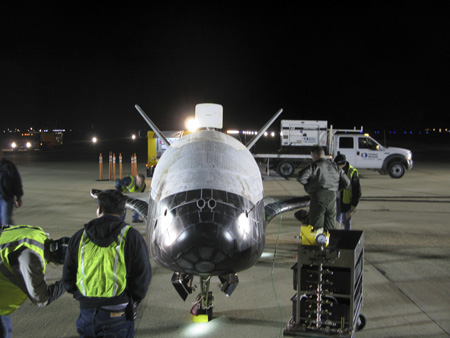The U.S. Air Force is evaluating the performance and condition of the X-37B Orbital Test Vehicle (OTV-1), the reusable space plane that lifted off in April and remains the subject of much international speculation.
The unmanned spacecraft landed at 1:16 a.m. Pacific Time on 3 December at Vandenberg AFB, in California after 224 days and nine hours in space.
Though the service is not discussing specifics about OTV-1's classified payload, air force insists the focus of the maiden flight was the aircraft, not the payload or even potential payloads.
"Our ability to launch it and our ability to operate it were two of the key steps in the programme," says Richard McKinney, deputy undersecretary of the air force for space programmes. "But then the ability to successfully autonomously recover and land the vehicle was really the culmination of this first test phase of the programme."
Speculation on USAF's intended uses for the reusable space plane range from a prototyped orbiting bomber to an enemy satellite killer to a way to rapidly deploy and repair spy satellites.
The air service, however, insists the programme is, at this stage, just an experimental aircraft.
"This is a test vehicle," McKinney says. "That's what it is, pure and simple." Should it continue into service after the testing phases, the aircraft would be used as a testbed to see how technologies and materials react to long-term exposure to space, he says.
"Think of is as a satellite you are able to put on orbit and bring back," he says.
 |
|---|
| © Boeing |
Much like a satellite, there are few opportunities for human intervention during the spaceplane's flight, says programme manager Lt. Col. Troy Giese. From the time it was carried into low-Earth orbit by an Atlas V rocket, OTV-1 flew a predetermined routine, including orienting itself for reentry and the turns and burns required to bleed off speed for landing the same way the manned space shuttle would. There is no way for anyone on the ground to take over the vehicle on landing, Giese says, though "there is a way to terminate the flight on final approach" if something goes wrong, he says.
The only anomaly during the night landing involved the left tire, which is about the size of a dinner plate and inflated to about 300psi. It reportedly blew out on rollout, possibly from hitting something on the runway, McKinney says. The tire shreds likely did some damage to the underside of the orbiter in addition to the seven instances of space-debris damage already identified, he says.
The X-37B dates to 1999 and a NASA Marshall Space Flight Center project with Boeing Phantom Works, which led in 2002 to a full development contract to produce an X-37 Approach and Landing Test (ALT) vehicle; an orbital flight version scheduled for launch in mid-2006 was never built. In 2004 NASA gave the programme to the Defense Advanced Research Projects Agency which then transferred it to the USAF's rapid capabilities office. In September 2006 DARPA oversaw Boeing B-52 drop tests of the X-37 ALT, releasing it from 46,000ft to demonstrate re-entry trajectory descent and landing capabilities.
Boeing is currently at work on a second orbiter, OTV-2, which the air force plans to fly sometime in spring 2011. McKinney would not comment on the partially classified programme's price tag. Debris damage, performance of the next-generation thermal tiles installed on OTV-1 and the effects of such an extended trip to space will all be thoroughly assessed before a date is set for the next mission.
Source: Flight International






















